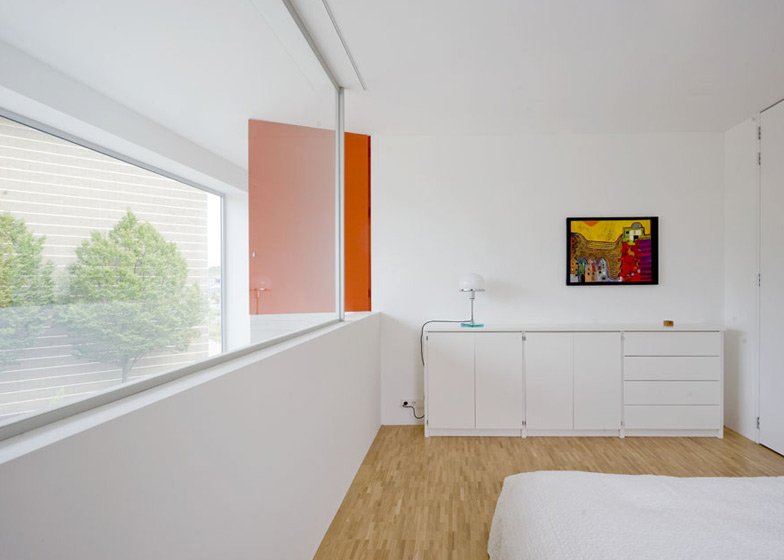Horizontal grooves create tactile stripes across the plaster-covered walls of this house in Leiden, the Netherlands, by architects GAAGA (+ slideshow).
Named Stripe House, the three-storey residence is one of the 670 architect-designed homes being completed in the residential district masterplanned by architects MVRDV.
The building is located at the end of a row of houses and the stripes wrap around all three exposed elevations.
"The grooves are not purely decorative, but also have an architectural function," architect Arie Bergsma told Dezeen. "They enhance the ‘all-sidedness’ of the volume, to link the facades and enhance the perspectival effect of the cube-like shape."
Bergsma also explained how the grooves make the facade more tactile. "The funny thing that we did not expect is that a lot of people are actually touching the facade with their hands," he said.
The stripy grey walls also extend beyond the front of the house to enclose a small garden, which leads residents into the dining room and kitchen on the first floor.
A concrete staircase connects the ground floor with the first floor living room, while metal stairs lead up to bedrooms on the top floor.
We're previously featured other housing projects from the development zone in Leiden. See them all here, including two others by GAAGA.
Photography is by Marcel van der Burg.
Here are a few words from GAAGA:
Stripe House
Stripe House is a small, mixed-use house located in the city of Leiden, The Netherlands. It takes its name from the characterizing horizontal stripes carved deep into the façade.
The house resides in a new urban planning area where clients can develop their own houses. It is on a corner plot adjacent to the park nearby and south-east of pedestrian streets.
Despite its limited size, the plot is not entirely built on. One quarter of the plot is reserved for a small enclosed garden, creating a soft transition from public to private space as well as a distance to neighbouring houses. Opting for a garden implied also a concentration of program on one side of the plot.
The cube-like structure encloses a stacking of three floors, all similar in size but different in program. Going upwards the functions have an increasingly private nature. The ground floor houses the office space and the patio, the next level contains the kitchen, living and dining space, while the upper floor holds two bedrooms and a bathroom.
The large void along the north façade is the focal point in the house. It connects the two upper floors and it spatially zones the kitchen area. The enormous window at the top offers an abundance of natural light as well as an impressive and poetic sight on the Dutch sky.
Because the house is situated on a corner it has an almost all-round orientation and presence. There are not many window openings, but the ones that are present are large and oriented towards interesting views. On the first floor the three windows together form a triptych. They show three different scenes each representing a specific side of the house: the park on the east side, the neighboring houses on the west and the sky on the north.
Plans - click above for larger image
The huge exterior walls are made tangible and appealing by means of horizontal grooves in the plaster. The grooves, with a total length of approximately 7000 meters, are handmade and carved into a semi-hardened plaster by using several moulds. The result is an unparalleled piece of craftsmanship.
Section
The Stripe house is also a very sustainable house that scores well in several energy performance and environmental index calculations and labels.
Elevation detail
Architects: GAAGA
Team: Esther Stevelink and Arie Bergsma
Location: Leiden, The Netherlands
Realisation: 2010 - 2012
Contractor: Verbeij Bouw, Boskoop.
Plasterwork: Mulder Afbouw - Maarten Mulder
Structural Engineering: IMD Raadgevende Ingenieurs BV, Rotterdam
Energy performance & building physics: GAAGA - Arie Bergsma
Paintings: Marion van Egmond, Emmy Stevelink-Willemsen









